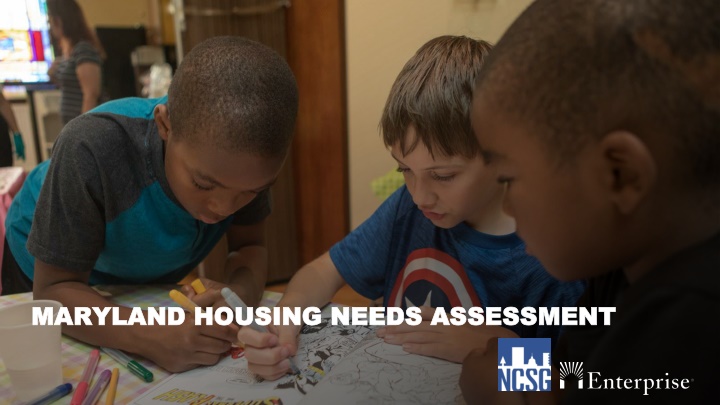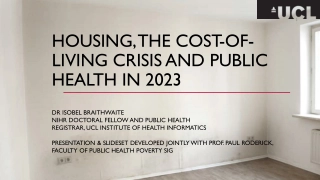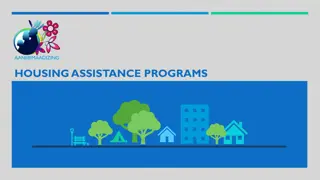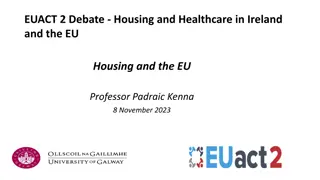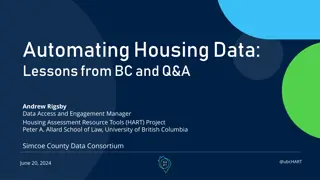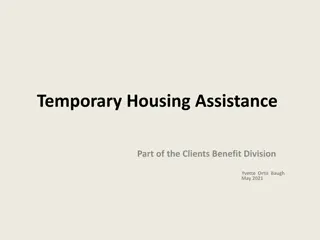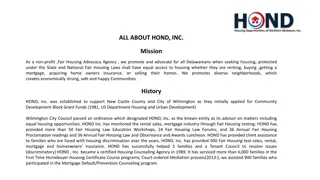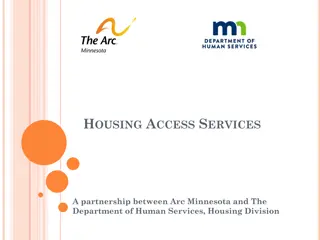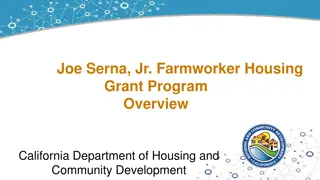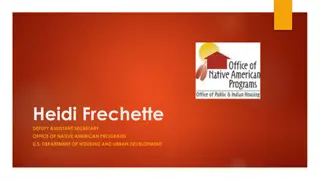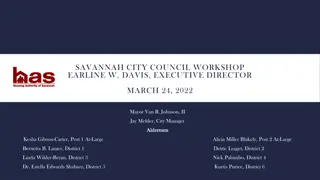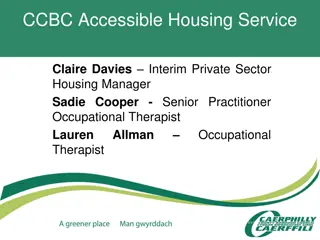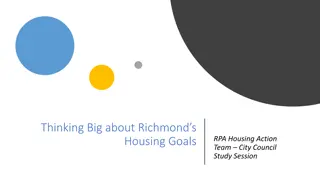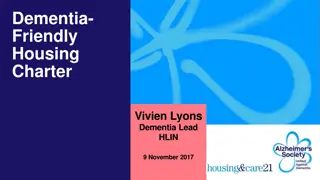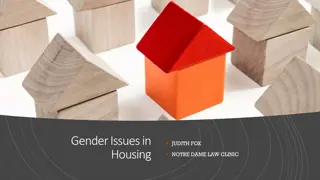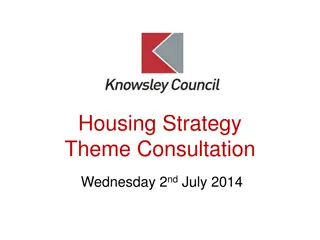Maryland Housing Needs Assessment Overview
The Maryland Housing Needs Assessment project aims to provide an accurate analysis of housing needs in Maryland, proposing recommendations and policy tools to meet the needs of diverse income groups from 2020 to 2030. The report covers current conditions, future projections, regional disparities, and a menu of suggested actions across 300 pages, emphasizing statewide priorities and policy reviews.
Download Presentation

Please find below an Image/Link to download the presentation.
The content on the website is provided AS IS for your information and personal use only. It may not be sold, licensed, or shared on other websites without obtaining consent from the author.If you encounter any issues during the download, it is possible that the publisher has removed the file from their server.
You are allowed to download the files provided on this website for personal or commercial use, subject to the condition that they are used lawfully. All files are the property of their respective owners.
The content on the website is provided AS IS for your information and personal use only. It may not be sold, licensed, or shared on other websites without obtaining consent from the author.
E N D
Presentation Transcript
MARYLAND HOUSING NEEDS ASSESSMENT MARYLAND HOUSING NEEDS ASSESSMENT 1 1
Agenda Introduction Overview of Housing Needs Assessment Tools in the document Data indices Online mapping Q&A 2
What is the NCSG? Research center at UMD College Park Based in the School of Architecture, founded in 2000 Technical assistance to local and state government; grant recipient from NSF, federal government, foundations 5 urban planning faculty 15 staff and student employees Mission: The NCSG works to create a more sustainable, vibrant and enhanced quality of life for communities across the globe. While we continue to address smart growth issues around the world, we are also engaged extensively at the local level on issues like housing, transportation, climate, and equity. We did the opportunity mapping about 7 years ago for the sustainable communities initiative Opportunity Collaborative. 3
The Maryland Housing Needs Assessment 4
Background on the HNA 2018: State legislative mandate to DHCD to conduct the needs assessment 2019: RFP out NCSG and Enterprise Community Partners apply and are selected, summer 2019 Fall 2019: NCSG and Enterprise begin work March-Fall 2020 = COVID delays! December 2020: project wraps up February 2021: release of final report 5
ASSESSMENT OVERVIEW PROJECT GOALS PROJECT GOALS MARYLAND HOUSING NEEDS ASSESSMENT MARYLAND HOUSING NEEDS ASSESSMENT Provides accurate analysis about housing needs in the State of Maryland between 2020 and 2030. Proposes a menu of recommendations, including new tools at the state and local levels to better align with current and future housing needs. Focuses on ways to meet the needs for all income groups, including those affecting families earning 30% and 60% of area median income. 6 6
Whats in this report? Its 300 pages! Proposed statewide priorities What are the biggest issues? Assessment of current and future conditions Supply, demand, projected demographic and economic situation Identification of needs by region How do needs in the housing market differ across the state? Policy toolbox A menu of actions not a prescriptive policy roadmap Appendices State and local policy review Engagement summary Technical documentation Supplementary data 7
ASSESSMENT OVERVIEW THREE SUPPORTIVE TOOLS THREE SUPPORTIVE TOOLS MARYLAND HOUSING NEEDS ASSESSMENT MARYLAND HOUSING NEEDS ASSESSMENT Renter Stability Index Maryland s Housing Toolbox Homeowner Stability Index Full Housing Needs Assessment | Renter & Homeownership Stability Indices | Maryland Housing Toolbox 8 8
TOOLS PROVIDED IN THE TOOLS PROVIDED IN THE HOUSING NEEDS HOUSING NEEDS ASSESSMENT: ASSESSMENT: INDICES INDICES 9 9
Needs by geography/Indices Two numeric indices Every census tract in the state Ranked within each of the 5 regions Comparable scores across the state Organizes tracts from lowest to moderate to highest need Data is shared with the public (housing needs assessment tables folder on DHCD website) Online mapping 10
PRIORITY NEEDS BY GEOGRAPHY: BACKGROUND APPROACH APPROACH TO IDENTIFY TO IDENTIFY PRIORITY NEEDS PRIORITY NEEDS DEFINING REGIONS We used the five regions identified for this project (see map): 1. Washington suburbs 2. Greater Baltimore 3. Southern Maryland 4. Western Maryland 5. Eastern Maryland COMPARING RESULTS The index values are comparable statewide, but tracts are ranked by quintile uniquely in each region. This allows comparison of differences in a region. 11 11
PRIORITY NEEDS BY GEOGRAPHY: BACKGROUND APPROACH APPROACH TO IDENTIFY PRIORITY NEEDS TO IDENTIFY PRIORITY NEEDS Data 2013- 2017 ACS 2000 SF3 Census Corelogic HUD NHPD 1394 census tracts in Maryland Z-scores computed relative to state average Capped at 3.5/+3.5 Tracts separated into regions, split into equal quintiles (lowest need to highest need) in each region More on methods: appendix F 12 12
PRIORITY NEEDS BY GEOGRAPHY: BACKGROUND PRIORITY NEEDS BY GEOGRAPHY PRIORITY NEEDS BY GEOGRAPHY HOMEOWNER INDEX METHODS HOMEOWNER INDEX METHODS GOAL GOAL VARIABLES VARIABLES Create an index that shows where homeowners are most stressed and the housing market needs the most support. RESULTS RESULTS HIGHEST NEED MEANS Tracts with high poverty rates, older housing, high cost burdens, high rates of crowding, low home prices, and high shares of delinquent or foreclosed loans, Age of housing Turnover/mobility Home prices Share of population 65+ Foreclosures and delinquency Housing construction trends Cost burdens among owners Poverty rate Median income LEAST IN NEED MEANS Tracts with high incomes, newer housing, lower cost burdens,high home prices, and few foreclosures or delinquencies. 13 13
RENTER STABILITY: A COMMON WAY TO LOOK AT NEED RENTER NEEDS BY GEOGRAPHY RENTER NEEDS BY GEOGRAPHY INDEX METHODS INDEX METHODS GOAL GOAL Identifies areas where renters are stressed by cost and the rental market needs to serve vulnerable residents across Maryland. VARIABLES VARIABLES Age of housing Turnover/mobility Rents Poverty rate Concentrated poverty by race Share of population 65+ Share of population w. a disability Housing construction trends Cost burdens among renters Existing subsidized housing RESULTS RESULTS HIGHEST NEED MEANS Tracts with high poverty rates, older housing, high rents, high cost burdens, high rates of crowding, and large shares of residents receiving assistance. LEAST IN NEED MEANS Tracts with high incomes, newer housing, lower cost burdens, and lower shares of renters receiving assistance. 14 14
Needs by geography web links Links to the renter and homeowner stability index maps are here available on page 32 of report, please see Appendix F of the report for technical documentation and a brief user's guide Statewide Western MD Washington DC Suburbs Greater Baltimore Eastern MD Southern MD 15
THE BALTIMORE REGION THE BALTIMORE REGION A closer look A closer look 16 16
Baltimore Region Summary findings Summary findings Largest region nearly half the state lots of differences within and between counties and the CIty In most ways, the area is average because it has so much of the housing stock, but rents and home prices are a bit lower than the state average overall Biggest concerns: older housing stock, high cost burdens, high poverty and low incomes, 17 17
PRIORITY NEEDS BY GEOGRAPHY: OWNER STABILITY GREATER BALTIMORE GREATER BALTIMORE OWNER PRIORITY OWNER PRIORITY NEEDS NEEDS Largest increase in home prices since 2000 (+51%) Lower-than-average home prices in 2017 ($271,858) Low delinquency rate (0.4%) & foreclosure rate (0.1%) Older housing stock (only 9% of units built since 2000)* *Housing need is not tenure-specific. 18 18 18 18
Baltimore Region Homeownership Index Homeownership Index for more, see appendix G for more, see appendix G Detailed breakdown of the statistics and comparison to state levels Analysis of each of the 5 categories of need for example, for homeowner index: 19 19
Baltimore Region Homeownership needs and Homeownership needs and actions actions 20 20
PRIORITY NEEDS BY GEOGRAPHY: RENTER STABILITY GREATER BALTIMORE GREATER BALTIMORE RENTER PRIORITY RENTER PRIORITY NEEDS NEEDS High share of renters (34%) High rental assistance utilization (across assisted units, vouchers, and other rental assistance) Moderate renter cost-burden rate (45%) Lower-than-average median rent ($1,424) Older housing stock (only 9% of units built since 2000)* 21 21 21 21 *Housing need is not tenure-specific.
Baltimore Region Rental Index Rental Index for more, see appendix G for more, see appendix G Detailed breakdown of the statistics and comparison to state levels Analysis of each of the 5 categories of need for example, for rental index: 22 22
Baltimore Region Rental market needs and Rental market needs and actions actions 23 23
Needs by geography web links Links to the renter and homeowner stability index maps are here available on page 32 of report, please see Appendix F of the report for technical documentation and a brief user's guide Statewide Western MD Washington DC Suburbs Greater Baltimore Eastern MD Southern MD 24
COMMENTS OR QUESTIONS COMMENTS OR QUESTIONS 25 25
THANK YOU THANK YOU PHOTO CREDITS: ODI via Flickr | Maryland Govpics | Jay Baker via Flickr | Joseph A via Flick | Doug Kerr via Flickr 26 26
